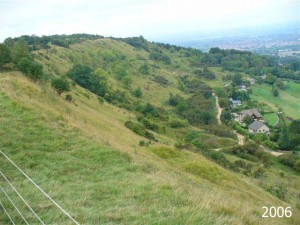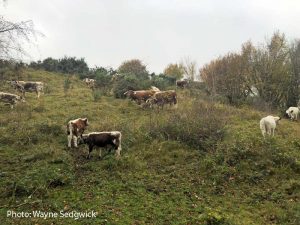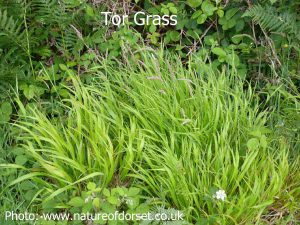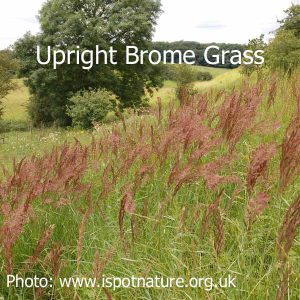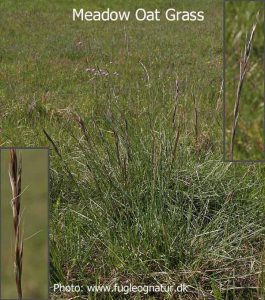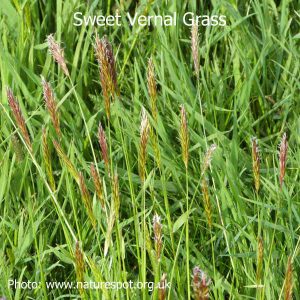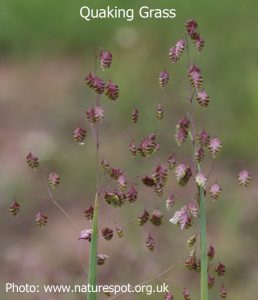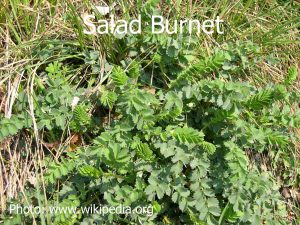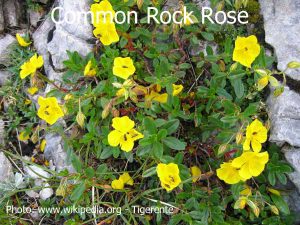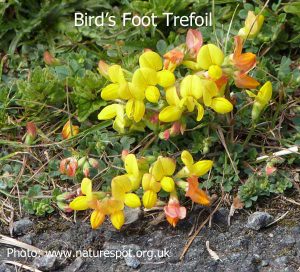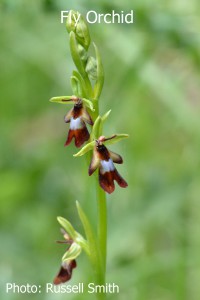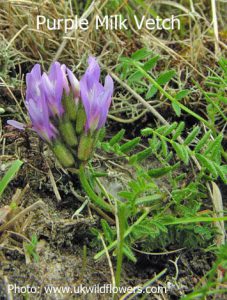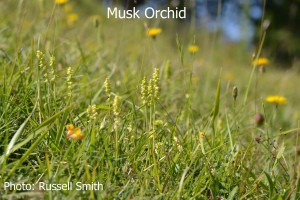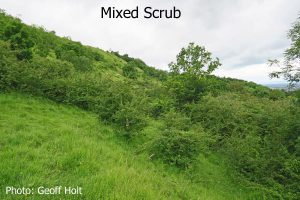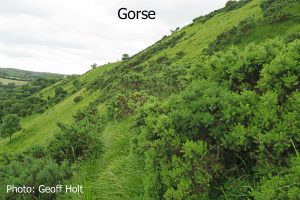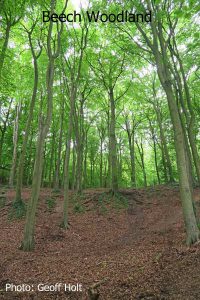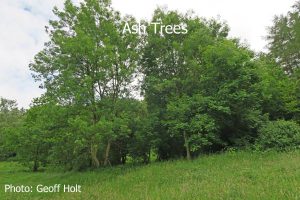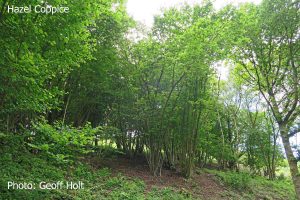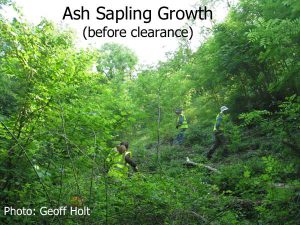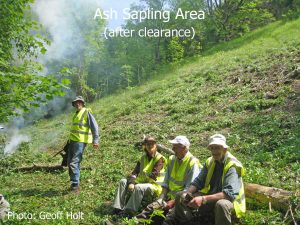Leckhampton Hill & Charlton Kings Common is of considerable biological importance in a local, regional and national context, principally due to the extent of the ‘unimproved limestone grassland’* and for the presence of nationally scarce species. As a result much of the site has been designated as a Site Of Special Scientific Interest.
* The Cotswolds AONB organisation defines ‘unimproved limestone grassland’ as: wildflower rich grassland that has not been affected by modern farming methods. The grassland has not been ‘improved’ with fertilizer or herbicides or reseeded to produce more grass for agriculture. It is found on shallow, free draining and alkaline soils.
As well as the unimproved limestone grassland, the other principal habitats on the Hill and Common are scrub and woodland, with scree and rock faces being subsidiary habitats.
An article on the biodiversity on the site can be found on page 6 of FOLK Newsletter Issue 09 September 2002.
In their 1957 history of the village, the Leckhampton Women’s Institute included an article on the local flora and fauna which has been repeated on page 5 of FOLK Newsletter Issue 58 Winter 2018 along with some commentary on changes that have occurred over the 61 years since then. Further commentary on this was included on page 11/12 in the Spring 2019 newsletter FOLK Newsletter Issue 59 Spring 2019.
The following provides a snapshot of the plants and trees on the site.
Grassland
Unimproved limestone grassland is the most important and extensive feature on the site and is an important wildlife habitat because it sustains a wide range of plants and invertebrates such as butterflies and rare snails. The main area of grassland is to be found on the open area of Charlton Kings Common which is grazed by a mixed herd of British Whites and English Longhorn cattle during the winter months, i.e. outside the plant flowering period.
Cheltenham Borough Council’s document ‘Leckhampton Hill and Charlton Kings Common Management Plan’, Issue 2, April 2003 (which can be found at CBC 2003 Management Plan) identified that this grassland consists mainly of tor-grass and upright brome with meadow oatgrass, sweet vernal grass and quaking grass.
It also identified that there were herb species present including salad burnet, common rock rose and common bird’s foot trefoil, and,…
…in addition, some plants that are scarce at local, county or national level, such as fly orchid, purple milk vetch and the nationally scarce musk orchid were also present.
Articles on grasses and wild flowers found in grassland can be found on: page 6 of FOLK Newsletter Issue 20 Summer 2005 (grasses); page 5 of FOLK Newsletter Issue 46 Autumn 2014 (Hemp Agrimony); page 5 of FOLK Newsletter Issue 35 Autumn 2010 (wild flowers); page 5 of FOLK Newsletter Issue 11 March 2003 (orchids), page 14 of FOLK Newsletter Issue 69 Summer 2022 (wild flowers).
Scrub
There is extensive scrub development over parts of the site. These are found on both the Leckhampton Hill and the Charlton Kings Common areas.
The density of scrub across the site is variable with some areas being relatively lightly scrubbed whilst others have a high density and are potentially developing into woodland. Some of the scrub areas support a limestone grassland herb layer. In other areas the grassland has been shaded out and hence a management regime of cutting is required to stop it dominating the more important grassland too much.
Two principal types of scrub can be distinguished: mixed broadleaf scrub dominated by hawthorn with blackthorn, bramble and wild rose; and gorse scrub consisting of gorse with occasional pockets of ash regeneration (but less so now with the advance of ash dieback disease). The scrub provides a food source for nesting birds, such as meadow pipit and grasshopper warbler, and also shelter for invertebrates and small mammals.
Although limestone grassland is the main nature conservation value of the site, scrub is also an important habitat that deserves to be conserved. Various species of plants, insects, birds, reptiles, mammals and fungi are associated with scrub, or use it at some stage of their life cycle. Insects dominate this list, with different species using scrub for purposes such as: a source of plant food, ranging from pollen to dead wood; shelter from inclement conditions; a nesting or egg-laying site; an over-wintering site or a site to warm up in the sun after cold periods. Many species will only be found in certain types of scrub, of a particular age and condition and in an appropriate location.
Thus it would be inappropriate to remove all shrubby vegetation just as it would be disastrous to allow scrub to occupy too much of the site. However, scrub cannot be left to its own device as ageing scrub may lack some features essential to some of the key species and can develop into woodland. The answer is that scrub should be managed to maintain a dynamic, changing system.
Articles on scrub can be found on: pages 4-5 of FOLK Newsletter Issue 36 Spring 2011 (general); page 4 of FOLK Newsletter Issue 22 Winter 2005 (bramble); page 8 of FOLK Newsletter Issue 21 Autumn 2005 (gorse).
Woodland
An element of broadleaved and coniferous woodland occurs on the site with the Leckhampton Hill side of the site being the principal woodland area. The woodland includes stands of mature beech, secondary ash woodland, Hazel coppice and conifer plantations.
Ash has been a particularly predominant woodland species that was, prior to the invasion of ash dieback disease, a prolific spreader of seeds which resulted in many ash saplings growing which could impact on the grassland. As such, it was necessary to manage this impact by regularly removing seeded ash saplings.
The site has been hit badly by ash dieback disease with a lot of ash trees now dying or dead. This has meant that a significant number have had to be felled, particularly close to the main footpaths, for health and safety reasons. Articles on ash dieback can be found on: page 7 of FOLK Newsletter Issue 63 Summer 2020; page 23 of FOLK Newsletter Issue 64 Autumn 2020: page 23 of FOLK Newsletter Issue 68 Spring 2022: page 7 of FOLK Newsletter Issue 70 Autumn 2022.
Articles on trees can be found on: page 4 of FOLK Newsletter Issue 35 Autumn 2010 (general); page 6 of FOLK Newsletter Issue 19 Spring 2005 (ash); page 3 of FOLK Newsletter Issue 18 Winter 2004 (general).
Further Detail
For further details see Cheltenham Borough Council’s document ‘Leckhampton Hill and Charlton Kings Common Management Plan’, Issue 2, April 2003 which can be found at CBC 2003 Management Plan
In addition, two detailed lists of plants and trees identified in botanical surveys undertaken in 2002 and 2014 are provided below.
2002 Survey
The following list provides a full account of those species found on the whole site (including Leckhampton Hill, Charlton Kings Common, Daisybank Field and Cowslip Meadow) during a botanical survey undertaken in June/July 2002 as input to Cheltenham Borough Council’s 2003 Management Plan for Leckhampton Hill and Charlton Kings Common.
| Scientific Name | Common Name |
| Acer campestre | Field maple |
| Acer pseudoplatanus | Sycamore |
| Achillea millefolium | Yarrow |
| Acinos arvensis | Basil thyme |
| Agrimonia eupatoria | Hemp agrimony |
| Agrostis stolonifera | Creeping bent |
| Ajuga reptans | Bugle |
| Allium ursinum | Ramsons |
| Alopercurus pratensis | Meadow foxtail |
| Anacamptis pyramidalis | Pyramidal orchid |
| Anthoxathum odoratum | Sweet vernal grass |
| Anthriscus sylvestris | Cow parsley |
| Arctium minus | Lesser burdock |
| Arenaria serpyllifolia | Thyme-leaved sandwort |
| Arrhenatherum elatius | False oat grass |
| Arum maculatum | Lords and ladies |
| Bellis perennis | Daisy |
| Betula pendula | Silver birch |
| Blackstonia perfoliata | Yellow wort |
| Brachypodium pinnatum | Tor grass |
| Brachypodium sylvaticum | False brome |
| Briza media | Quaking grass |
| Bromus erectus | Upright brome |
| Bromus mollis | Soft brome |
| Calystegia sepium | Hedge bindweed |
| Carex caryophyllea | Spring sedge |
| Carex flacca | Glaucous sedge |
| Centaurea nigra | Black knapweed |
| Centaurea scabiosa | Greater knapweed |
| Centranthus ruber | Red valerian |
| Cephalanthera damasonium | White helleborine orchid |
| Cerastium fontanum | Common mouse ear |
| Chamaenerion angustifolium | Rosebay willowherb |
| Cirsium acaule | Stemless thistle |
| Cirsium arvense | Creeping thistle |
| Cirsium eriophorum | Woolly thistle |
| Cirsium vulgare | Spear thistle |
| Clematis vitalba | Traveller’s joy |
| Corylus aveellana | Hazel |
| Cotoneaster sp. | Cotoneaster |
| Crataegus monogyna | Common hawthorn |
| Cynosurus cristata | Crested dog’s tail |
| Dactylis glomerata | Cocksfoot |
| Dactylorhiza fuchsii | Common spotted orchid |
| Dryopteris felix-mas | Male fern |
| Echium vulgare | Viper’s bugloss |
| Epipactis helleborine | Broad-leaved helleborine orchid |
| Euphrasia sp. | Eyebright sp. |
| Fagus sylvatica | Beech |
| Festuca ovina | Sheep’s fescue |
| Festuca rubra | Red fescue |
| Filipendula vulgaris | Dropwort |
| Fragaria vesca | Wild strawberry |
| Fraxinus excelsior | Ash |
| Galium aparine | Cleavers |
| Galium cruciata | Crosswort |
| Galium mollugo | Hedge bedstraw |
| Galium verum | Lady’s bedstraw |
| Geranium robertianum | Herb Robert |
| Geum urbanum | Herb Bennett |
| Hedera helix | Ivy |
| Helianthemum nummularium | Common rock rose |
| Helictotrichon pratense | Meadow oat grass |
| Herachleum sphondylium | Hogweed |
| Herminium monorchis | Musk orchid |
| Hieracium pilosella | Mouse-ear hawkweed |
| Hieracium sp. | Hawkweed sp. |
| Hippocrepis comosa | Horseshoe vetch |
| Holcus lanatus | Yorkshire fog |
| Hypericum perforatum | Perforate St John’s wort |
| Hypocaeris radicata | Common cat’s ear |
| Koeleria macrantha | Crested hair-grass |
| Leontodon sp. | Hawkbit species |
| Leucanthemum vulgare | Ox-eye daisy |
| Ligustrum vulgare | Wild privet |
| Linum cartharticum | Fairy flax |
| Listera ovata | Common twayblade orchid |
| Lolium perenne | Perennial rye grass |
| Lotus corniculatus | Bird’s foot trefoil |
| Malus sylvestris | Wild apple |
| Mercurialis perennis | Dog’s mercury |
| Mentha aquatica | Water mint |
| Odontites verna | Red bartsia |
| Ophrys apifera | Bee orchid |
| Ophrys insectifera | Fly orchid |
| Phleum pratense | Timothy grass |
| Pimpinella saxifraga | Burnet saxifrage |
| Plantago lanceolata | Ribwort plantain |
| Plantago major | Greater plantain |
| Plantago media | Hoary plantain |
| Poa pratensis | Smooth meadow grass |
| Poa trivialis | Rough meadow grass |
| Polygala vulgaris | Common milkwort |
| Potentilla anserina | Silverweed |
| Potentilla erecta | Tormentil |
| Primula veris | Cowslip |
| Prunella vulgaris | Selfheal |
| Prunus spinosa | Blackthorn |
| Quercus robur | Pedunculate oak |
| Ranunculus bulbosus | Bulbous buttercup |
| Ranunculus repens | Creeping buttercup |
| Rhinanthus minor | Yellow or hay rattle |
| Rhodedendron ponticum | Rhodedendron |
| Rosa arvensis | Field rose |
| Rosa canina | Dog rose |
| Rubus fruticosus | Bramble |
| Rumex acetosa | Sorrel |
| Salix capraea | Goat willow |
| Salix cinerea | Grey willow |
| Sambucus nigra | Elder |
| Sanguisorba minor | Salad burnet |
| Sanicula europaea | Sanicle |
| Senecio jacobaea | Common ragwort |
| Silene dioica | Red campion |
| Silene vulgaris | Bladder campion |
| Stachys officinalis | Betony |
| Succisa pratensis | Devil’s bit scabious |
| Tamus communis | Black bryony |
| Taraxacum officinale | Dandelion agg. |
| Teucrium scorodonia | Wood sage |
| Thymus praecox | Wild thyme |
| Tragopogon pratensis | Goatsbeard |
| Trifolium campestre | Hop trefoil |
| Trifolium dubium | Lesser trefoil |
| Trifolium pratense | Red clover |
| Trifolium repens | White clover |
| Trisetum flavescens | Yellow meadow grass |
| Ulex europaeus | Common gorse |
| Urtica dioica | Nettle |
| Veronica chamaedrys | Germander speedwell |
| Viburnum lanata | Wayfaring tree |
| Vicia sepium | Bush vetch |
| Viola hirta | Hairy violet |
2014 Survey
The following list records those species identified during a botanical survey undertaken by Gloucestershire Wildlife Trust on Cowslip Meadow in June 2014.
| Scientific Name | Common Name |
| Acer campestre | Field Maple |
| Anacamptis pyramidalis | Pyramidal Orchid |
| Anthoxanthum odoratum | Sweet Vernal-grass |
| Bellis perennis | Daisy |
| Brachypodium pinnatum | Heath False-brome |
| Briza media | Quaking-grass |
| Bromopsis erecta | Upright Brome |
| Carex flacca | Glaucous Sedge |
| Centaurea scabiosa | Greater Knapweed |
| Cerastium fontanum | Common Mouse-ear |
| Cirsium acaule | Dwarf Thistle |
| Cirsium arvense | Creeping Thistle |
| Cirsium eriophorum | Woolly Thistle |
| Clematis vitalba | Traveller’s-joy |
| Clinopodium vulgare | Wild Basil |
| Convolvulus arvensis | Field Bindweed |
| Crataegus monogyna | Hawthorn |
| Cruciata laevipes | Crosswort |
| Dactylis glomerata | Cock’s-foot |
| Dactylorhiza fuchsii | Common Spotted-orchid |
| Festuca pratensis | Meadow Fescue |
| Fraxinus excelsior | Ash |
| Geranium pratense | Meadow Crane’s-bill |
| Heracleum sphondylium | Hogweed |
| Holcus lanatus | Yorkshire-fog |
| Hypericum hirsutum | Hairy St John’s-wort |
| Hypericum maculatum | Imperforate St John’s-wort |
| Hypericum perforatum | Perforate St John’s-wort |
| Knautia arvensis | Field Scabious |
| Lathyrus pratensis | Meadow Vetchling |
| Leontodon hispidus | Rough Hawkbit |
| Leucanthemum vulgare | Oxeye Daisy |
| Neottia ovata | Common Twayblade |
| Lotus corniculatus | Common Bird’s-foot-trefoil |
| Medicago lupulina | Black Medick |
| Origanum vulgare | Wild Marjoram |
| Plantago lanceolata | Ribwort Plantain |
| Plantago major | Greater Plantain |
| Plantago media | Hoary Plantain |
| Poa pratensis | Smooth Meadow-grass |
| Potentilla anserina | Silverweed |
| Potentilla erecta | Tormentil |
| Primula veris | Cowslip |
| Ranunculus acris | Meadow Buttercup |
| Ranunculus repens | Creeping Buttercup |
| Rhinanthus minor | Yellow-rattle |
| Rosa | Rose |
| Rubus fruticosus agg. | Bramble |
| Sanguisorba minor | Salad Burnet |
| Senecio jacobaea | Common Ragwort |
| Silene dioica | Red Campion |
| Succisa pratensis | Devil’s-bit Scabious |
| Taraxacum | Dandelion Agg. |
| Tragopogon pratensis | Goat’s-beard |
| Trifolium pratense | Red Clover |
| Trifolium repens | White Clover |
| Trisetum flavescens | Yellow Oat-grass |
| Vicia cracca | Tufted Vetch |
| Vicia sativa | Common Vetch |
| Viola hirta | Hairy Violet |
